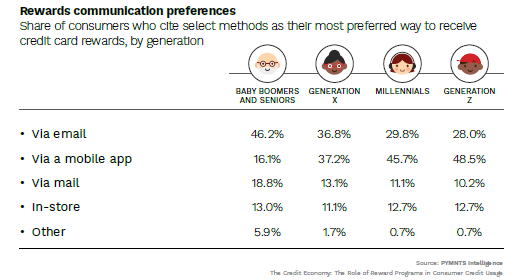Boomers Prefer Email, Gen Zs Opt for Apps as Top Choice for Reward Delivery

Adapting to the evolving preferences of the increasingly influential young consumer demographic has ushered in a transformative era for financial institutions (FIs), challenging the conventional approaches to fostering loyalty.
Take credit card rewards for example. Among consumers, the younger demographic stands out as the most interested in these programs. Yet, they also express the highest level of dissatisfaction, citing issues like extended redemption processes and a dearth of personalized offers as contributing factors.
Gen Z consumers, for instance — ages 18 to 25 — are particularly discontent with conventional rewards structures. The absence of innovative and personalized offers, key defining factors for this generation, has left them longing for more innovative alternatives that can better align with their evolving expectations.
These are some of the key findings detailed in “The Credit Economy: The Role of Reward Programs in Consumer Credit Usage,” a PYMNTS Intelligence and i2c collaboration. The research study draws on insights gathered from a survey of over 3,233 U.S. consumers to examine how consumers feel about credit card loyalty programs and what influences their interest and use of rewards in different spending categories and among various demographic groups.
According to the report, 60% of Gen Z consumers gravitate toward unconventional rewards, such as exclusive flash sales or special event access, in contrast to the long-held preference for cash-back rewards seen in older generations.

Distinct generational disparities extend to how rewards are communicated. Traditional methods like mailed promotions or in-store offers fail to resonate with Gen Z, who strongly prefer receiving rewards through mobile apps. In fact, nearly half of this demographic, along with approximately 45% of millennials, show a preference for app-based offers.
On the other hand, baby boomers and seniors still prefer email as their top choice for receiving rewards. The study found that 46% of boomers and seniors favor email delivery. Generation X falls in between, with 37% preferring email.
The popularity of physical mail, once a conventional method for communications, has dwindled across all age groups. Merely 10%, 11% and 18% of Gen Z, millennials and boomers still favor this approach.
“This divergence in preferences underscores a nuance in the ever-changing communication landscape: entities capable of providing a diverse range of digital methods for delivering rewards will position themselves most effectively to appeal to account holders spanning generations,” the study noted.
In terms of spending categories, younger cardholder cohorts, especially Gen Z, have a preference for rewards in categories such as clothing and accessories. This preference aligns with their values of independence and self-expression. On the other hand, older generations lean toward more traditional categories such as groceries and restaurant food.
Overall, the study highlights the need for credit companies to adapt their reward structures to cater to the preferences of different generations. Younger consumers value personalized and diverse rewards delivered through mobile apps, while older generations still prefer email. By understanding and meeting these preferences, credit companies can enhance customer satisfaction and foster loyalty among their customers for years to come.

